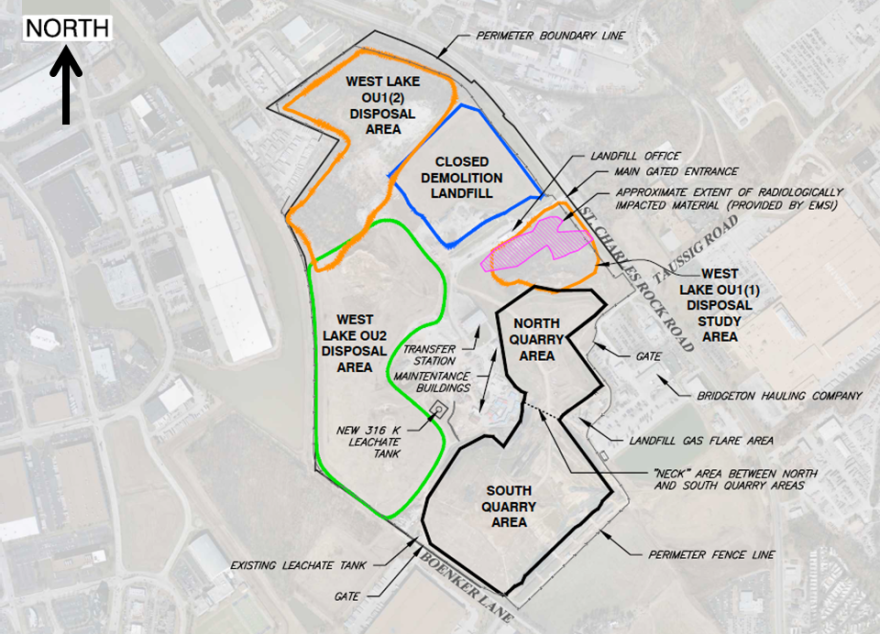Updated 1:00 a.m. after the landfill meeting - Hundreds of area residents jammed into the John Calvin Presbyterian Church in Bridgeton Thursday night for a meeting about two St. Louis County landfills.
Many people at the meeting had never heard of the Bridgeton and West Lake landfills until last week, when St. Louis County made public an emergency response plandescribing how it would respond if an underground fire at Bridgeton reaches radioactive waste at West Lake.

The county’s director of emergency management, Mark Diedrich, fielded questions from the crowd but could provide few answers.
“I can’t answer specific questions, because until a scenario occurs, I won’t know what’s going on. And I hope everybody kind of understands that.”
Diedrich said that if something does happen at the landfills, people will be asked to "shelter in place" for a few hours to give first responders time to assess the situation. "We can send monitors in, and meters in, and find out exactly what’s in the air, and find out exactly where it is," Diedrich said. "At that point, once we know that, we can then, if necessary, start an evacuation."
Diedrich recommended that every family prepare its own disaster plan, including contact information and plans for where to go during an evacuation.
Cole Kelley, a Ladue mother-of-three, was among those in the crowd who turned up to express their fear, confusion and frustration. She told Diedrich that everybody in the region needs to know about the landfills, and what could happen there. “You owe it to the residents of St. Louis to educate them that this is existing, and we need to prepare ourselves," Kelley said. "Not mass hysteria, but prepare. You just said it, we need to prepare.”
Read our preview of the meeting, below:
Anxiety is mounting over problems at a complex of landfills in north St. Louis County.
An underground fire has been smoldering at the Bridgeton Landfill for five years — about a thousand feet away from radioactive waste at the neighboring West Lake Landfill. Awareness of the situation spiked last week when St. Louis County made public an emergency response plan aimed to save lives if a “catastrophic event” were to occur at the landfills, releasing radioactive contamination into surrounding communities.
The county's plan dictates that some residents would stay indoors and "shelter in place," while others would need to be evacuated.

School districts around the landfill have sent letters to parents and staff in an effort to reassure them. But that move inadvertently spread alarm by raising awareness to even more people of the landfills' problems. In less than two weeks, a Facebook group that has been devoted to the West Lake Landfill for at least three years grew from about 3,700 members to almost 11,000.
Maryland Heights mother and citizen activist Dawn Chapman, who has been tracking the situation at the landfills for two and half years, said she can empathize with the fears of people who are just now finding out about the underground fire and nearby radioactive waste.
"These people cannot believe that they live in St. Louis, Missouri, and that there is any sort of plan in place for an event like this happening at the landfill," Chapman said. But she said people should not panic and that there is still time to act. "We need to come together, and we need to use whatever resources we have. We need to reach out to these elected officials, and we need to call them constantly. We need to make them fix this situation."

The U.S. Environmental Protection Agency, which has regulatory authority over the radioactive contamination at the West Lake Landfill, said the county's emergency plan has existed for more than a year and was developed in consultation with multiple emergency response organizations, including the EPA.
"The most important thing for families in St. Louis to know is that there is no imminent threat that the subsurface smoldering event (SSE) in the Bridgeton Landfill will reach the radiologically impacted materials (RIM) at the adjacent West Lake Landfill," the EPA said in an email to St. Louis Public Radio. "We have completed an initial review of the Missouri Attorney General’s documents and disagree with the findings that the SSE is rapidly moving towards the RIM and that the RIM could become explosive in a “Chernobyl” like event. In the unlikely event the SSE does reach RIM, we would anticipate a possible increase in release of gases, such as radon. The release of any gases would likely be localized and not occur over the entire landfill."
A community meeting about the West Lake and Bridgeton landfills will be held Thursday at 6:30 p.m. at the John Calvin Presbyterian Church, 12567 Natural Bridge Road, Bridgeton. Dawn Chapman said she expects an overflow crowd of more than 350 people to attend.
Follow Véronique LaCapra on Twitter: @KWMUScience





